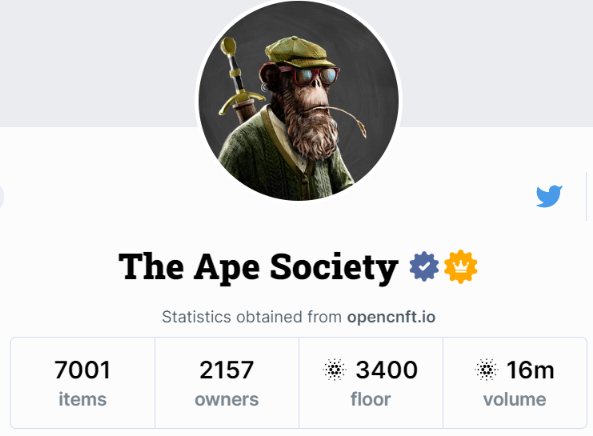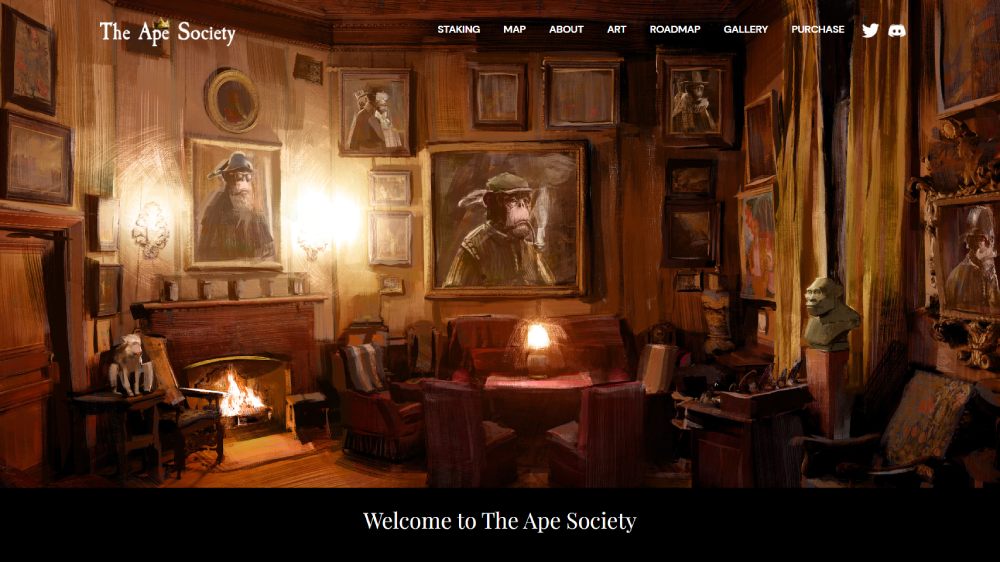Learn everything about the Ape Society NFT, an NFT project aiming to become the Cardano (ADA) blockchain’s answer to the Bored Ape Yacht Club.
Ask newer entrants to the NFT space, and they’ll complain about missing their chance to pick up a Bored Ape before their prices went parabolic. Although we can’t change the past, we can make sure not to miss the next BAYC, and the Ape Society is aiming to become the next big Ape-themed NFT project.
Inhabiting the Cardano (ADA) blockchain, the Ape Society is a collection of apes that are far more than cool-looking monkeys, thanks to their deep and rewarding ecosystem with their token, DeFi economy, DAO, and metaverse.
That the tokens have continued to trade at incredibly high volumes amid a brutal bear market shows how much potential they hold.
What should you know about the Ape Society NFT? Is it one of the best Cardano NFTs to date? In this guide, you’ll get all the information you need about the project to help you decide if you think these apes will moon as a valuable DeFi play or crash and burn, like most NFTS of 2022.
Table of Contents
The Ape Society’s Generative Design
Don’t judge a book by its cover. An NFT on the other hand… the first thing that draws someone’s attention to an NFT is the design, so it’s fundamental that creators design something distinctive.
The Ape Society comprises 7,000 characters unique due to the generative art system that assigns random features to every token. For example, some Apes wear futuristic sunglasses, while others come equipped with a sword or bow and arrow. These Apes look unlike other PFP collections and are a far cry from some cheap NFT projects.
Beyond the features that determine an Apes rarity, what stands out is the smooth brush stroke finish style, which sets them apart from other monkey-based NFT projects.
It’s clear the Ape Society makes a solid PFP project, but these Apes are vying for much more than a few Discord profile pictures. The ecosystem behind this Cardano project is impressive too.
DAO Democracy In The Ape Society

The Ape Society’s Decentralized Autonomous Organization (DAO) dictates the project’s future by incorporating the proposals of all Apes.
According to the project’s litepaper, any token holder can post a proposal through the official discord server. Proposals are vetted and debated by 11 council members elected every four months.
If the four council members decide that the proposal would benefit the Ape’s, they can fund its implementation through the treasury. While it might sound like a gimmick, the DAO is no joke. The council leaders and the community manage over $2.5 million in assets in multi-sig wallets protected by 11 councilors.
Some of the proposals made via the DAO have already been founded and developed, creating intriguing new features for the project.
1. The Amphitheatre
The Amphitheatre is a virtual world where Ape holders can compete in gladiator-style tournaments to win $SOCIETY and show off to the community. Even if you aren’t much of a fighter, Apes can get their hands on $SOCIETY through a rewards system based on admission fees from members of the Cardano community that don’t own an Ape.
Furthermore, the development of the Amphitheatre is carried out by Apes in exchange for $SOCIETY. In the future, the community wants to issue contracts as NFTs that will be used to prove that members have helped build the project. This idea could see users create NFT-based CVs for their Web 3.0 careers.
2. Societas Game
Societas is a Catana-style board game with unique features inspired by the Ape Society community. Players compete to build settlements, gather resources, and take down enemy positions. In addition, the DAO holds tournaments where the winners get $SOCEITY while some of the fees are used to fund the DAO treasury.
3. The Great Ape Debate
Democracy needs dialogue, and the Ape Society is well aware of this, which is why the DAO voted to create a forum for debate. Within the Discord server, the DAO votes on topics that people suggest, and then if they’re approved by both members and by the project’s team, they’re discussed by the Apes. The debate process allows users to test their ideas before submitting an official proposal to the council members.
The Ape Society Metaverse

Many blue chip projects like the Bored Apes and Clone X have succeeded because of their plans to build within the metaverse. A metaverse is a virtual world where members of an NFT community can socialize, play, and trade, potentially adding massive value to a project. The Ape Society has followed suit with its own metaverse plans.
Ape Cabins
Every existing Ape holder was whitelisted for a 3D Cabin that they received through an airdrop and now serves the community as a way into the metaverse. The supply of Cabins is limited to 10K, which leaves 3K available for purchase if you don’t make it onto the whitelist.
Judging by the Cabin video on the project’s official site, the cabins are highly detailed and provide several services to the Apes. The cabins are traded on the jpg.store, where they’ve accumulated an overall volume of nearly 4 million ADA. These Ape lodgings offer the following perks:
Personalize: The Ape Cabins are highly-customizable. Adding furniture, buying picture frames, and creating your own style will let you and your Ape leave a mark on the metaverse.
Entertainment: Apes chilling in the cabins can enjoy a game of billiards or listen to their favorite music on their retro gramophones.
Advertise: Users will be able to use their cabins for whatever they see fit, including to advertise separate groups that they’re a part of or to promote their own brands.
Address: The cabins are all sold with a unique address, including a district, street name, and postcode.
The cabins are an intriguing idea and clearly show that the project is far more than just another PFP project trying to make a quick buck on the general hype around Ape NFTs.
Another important aspect of this metaverse is the $SOCIETY token which will be used as the digital economy’s native currency.
$SOCIETY The Ape Society Token
At the heart of the Ape Society’s metaverse ambitions is the $SOCIETY utility token. Much like ApeCoin in BAYC, this token will be used internally for trading and externally by investors looking to gain exposure to the project without actually buying an NFT.
The token has a limited supply of 700 million, and it’s used by Ape holders to buy and upgrade frames, create decorative items, pay for real-life merchandise and offer a staking incentives program.
In a Medium posted this month, October 2022, post-Ape Society gave a detailed breakdown of the $SOCIETY token distribution, 65% is to be distributed through staking, and between 5-10% will be used for airdrops, projector rewards, liquidity, and various other features.
Interestingly the rarity of the Ape you stake will determine the amount of $SOCIETY you’ll be rewarded with, and to drive up the price of the token, all $SOCIETY spent on upgrades will be burnt to reduce the supply.
Ape DeFI: Farming $SOCIETY
Having a DeFi feature built into an NFT project always makes a project more appealing, especially during a bear market where turning a profit can be challenging. Becoming a member of the Ape Society might be your way of adding some passive income to your wallet.
Frames and Staking
In the City interface, you can manage your Apes, NFTS and purchase new frames for your cabin. As we already know, frames can be used to decorate your cabin and serve as a DeFi instrument.
Frames aren’t staked, but they are necessary for staking your NFTs and determining your returns. Frames are ranked from 0-7, with the higher levels offering better staking returns.
Frames can be upgraded using $SOCIETY, and every community member can mint a level 0 frame for 750 $SOCIETY. In addition, some Apes will get you free frames and discounts.
Every time a frame is minted or upgraded, $SOCIETY is burned, which should reduce its supply and drive up the price. Your staking rewards will vary based on your frame level, the number of NFTs you stake, and the class of your apes.
Ape Classes and DeFI
The 7,000 Apes have been divided into 35 families and eight classes offering unique perks related to the Cabins and $SOCIETY. The classes are established based on the story behind the project, also known as the Lore, in which different apes came together to build a civilized society far removed from the previous barbaric system.
By having a range of bonuses up for grabs based on classes the collection is more diverse and incentivizes people to purchase more than one Ape, and your DeFi rewards are influenced by the class of your Ape.
The following list is ascending, starting with the most common class and ending with the rarest.
Craftsmen: These apes are builders of Ape Society, and they can build non-frame items for cabins that can then be sold for %SOCIETY.
Artist: The chief entertainers in the Ape Society are the artists who receive one free frame for their cabins and a base multiplier of 1.15x for staking.
Explorers: These apes are apt at discovery and, as a result, get a 50% discount on frames and a staking multiplier of 1.35x.
Merchants: The merchants are the bankers of the Ape Society world, and they receive a 2% commission from sales in the Ape Society Market and a 1.45x staking reward multiplier.
Military Officers: The soldiers of the Ape Society give you the chance to receive free airdrops and generate a 1.7x staking multiplier.
Royal Advisors: The political heavy-weights of Ape Society boost staking rewards for other apes held by the user with a 1.2x multiplier, and their own base multiplier is 2.35x.
Nobles: The upper class of the Ape Society receives a larger first cabin than others with extra items and a staking multiplier of 7x.
Kings: The Ape Society Kings lead the 35 families giving them 1% of the rewards generated by every family member.
You can find a formula from the Ape Society here that helps you calculate your potential staking rewards.
The Ape Society Pools Initiative (TASPI)
TASPI is one of the DAO’s success stories that demonstrated the power of Ape democracy and furthered the DeFi potential of The Ape Society. TASPI selects seven independent ADA stake pools representing the Ape classes and releases rewards to them in $SOCIETY. The rewards are dispersed every ADA epoch. You can check which staking pools are currently being used by TASPI in the litepaper.
How To Buy Ape Society

If you’re considering taking advantage of ADA’s low price to pick up an Ape, follow these steps to buy an Ape:
- Wallet: Before getting started, ensure you have a compatible ADA wallet, such as Eternl or Nami, and load it with some ADA.
- Connect: Visit the official Ape Society page on jpg.store and connect your wallet by pressing the connect button in the top right-hand corner. Browse the collection.
- Browse: You can filter the Apes by class, family, traits, and price.
- Details: Click on the Ape you’re interested in, and you’ll then be able to check its properties. The properties will show how rare the NFT is, which eludes to its value.
- Buy: If you’re happy with the Ape and its traits, press the Buy Now button and complete the transaction.
- Check: Check you’re profile on jpg.store to see your Ape.
The Ape Society has a lot in common with BAYC. Still, it has also bought some original ideas to the table, and its success so far is reflected in its overall trading volume of over 16 million ADA.
Although the Apes in the upper classes are selling for over 100k ADA on the secondary market, thanks to the recent dip in ADA’s price, you can pick up an Ape for far less. Our guide also explains how to buy NFTs on Cardano.
Final Thoughts on Ape Society NFT
The NFT community has become skeptical of new Ape projects due to the countless low-effort BAYC imitators. The Ape Society appears to be more than just another cheap imitation.
The Ape Society offers excellent artwork combined with an extensive ecosystem that divides Apes into families and classes, offering rewards for holding the apes through perks that can be used to profit through various DeFi systems. In addition, Ape holders can carve out their own space in the metaverse through the cabins and influence the project’s future through the DAO.
The key risks are that it’s built on the Cardano blockchain. It’s a relatively unproven blockchain for NFTs to date and onboarding is trickier than with Ethereum NFTs. It’s also open to debate if the wider NFT market has space for another ape blue chip, no matter how creative.


